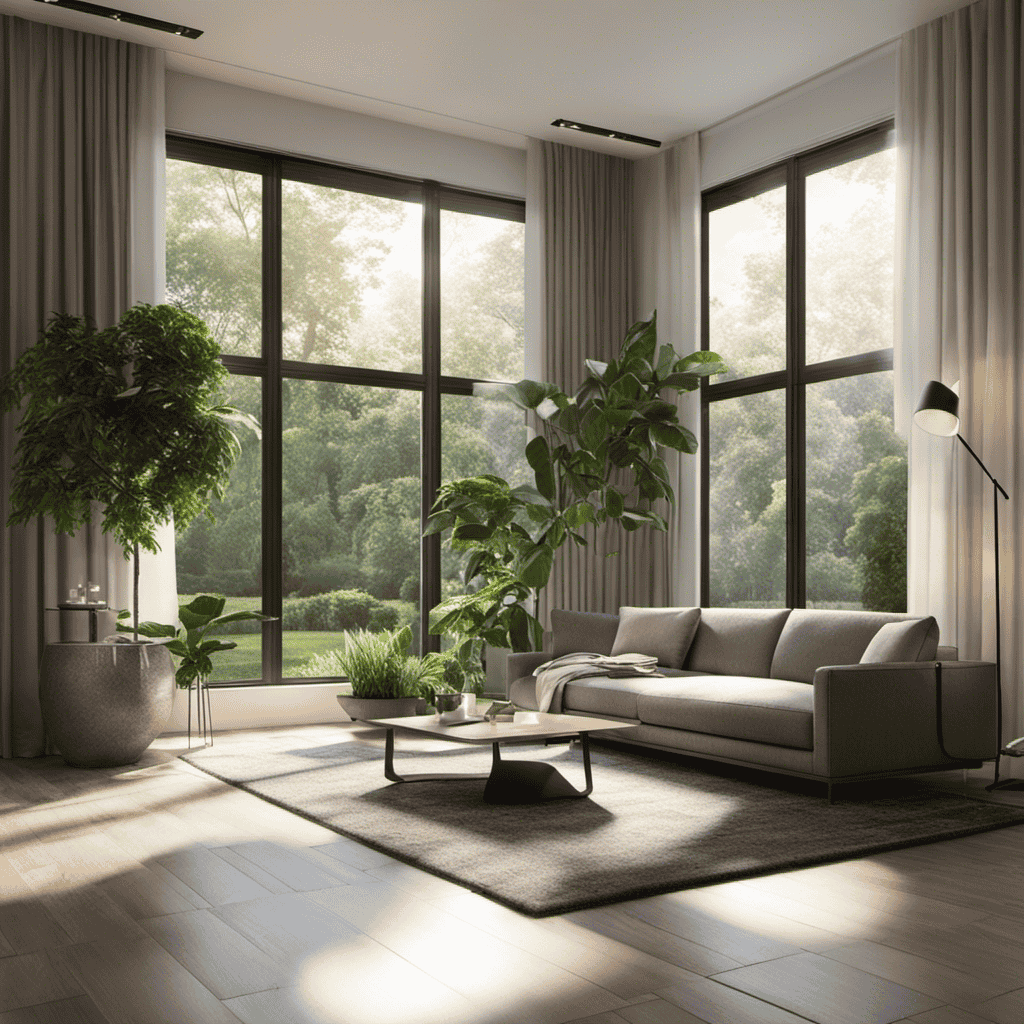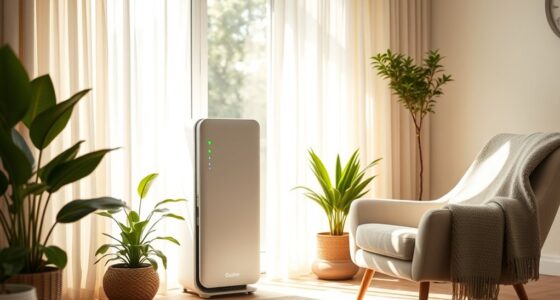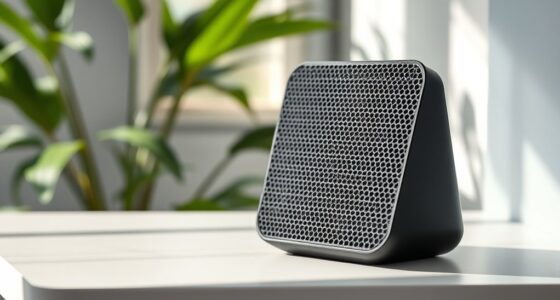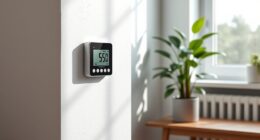As someone knowledgeable in indoor air quality, I frequently get asked, “What exactly is an air purifier?”
Well, let me tell you, an air purifier is a remarkable device that can greatly improve the quality of the air we breathe.
In this article, we will explore the benefits of using an air purifier, how they work, the various types available, and the key features to consider when purchasing one.
So, let’s dive into the world of air purifiers and discover the secrets behind their effectiveness.
Key Takeaways
- Air purifiers remove pollutants and allergens from the air, improving indoor air quality.
- They use various technologies such as HEPA filters, activated carbon filters, and UV germicidal irradiation to capture particles, remove odors, and destroy bacteria and mold spores.
- HEPA filters primarily capture solid particles, while activated carbon filters have a high adsorption capacity for gases and odorous compounds.
- Using an air purifier can provide health benefits such as reducing respiratory conditions and allergies, improving overall well-being, and creating a healthier living environment.
The Benefits of Using an Air Purifier
You’ll be amazed at the benefits of using an air purifier in your home.
Air purifiers are highly effective in removing pollutants and allergens from the air, ensuring a healthier living environment for you and your family.
These devices work by filtering out particles such as dust, pollen, pet dander, and even harmful gases like volatile organic compounds (VOCs).
The effectiveness of an air purifier depends on factors such as the size of the room, the type of pollutants present, and the efficiency of the purifier’s filtration system.
While the cost of an air purifier may vary depending on the brand and features, it is a worthwhile investment for those who suffer from allergies or respiratory conditions.
The long-term benefits of improved air quality far outweigh the initial cost of the device.
How Air Purifiers Work
When it comes to understanding how air purifiers work, it is essential to delve into the air purification process, the filter technology used, and the health benefits provided.
The air purification process typically involves the removal of airborne particles, such as dust, pollen, and pet dander, through a combination of filtration methods.
Various filter technologies, such as HEPA filters and activated carbon filters, are commonly utilized to trap and eliminate these pollutants from the air.
Air Purification Process
To understand how an air purifier works, it’s important to know about the air purification process. Air purification is the process of removing pollutants, allergens, and contaminants from the air to improve indoor air quality.
There are several different technologies used in air purifiers to achieve this, including:
-
High-Efficiency Particulate Air (HEPA) filters: These filters are designed to capture particles as small as 0.3 microns, including dust, pollen, pet dander, and mold spores.
-
Activated carbon filters: These filters are effective at removing odors, gases, and volatile organic compounds (VOCs) from the air.
-
Ultraviolet (UV) germicidal irradiation: This technology uses UV light to destroy bacteria, viruses, and mold spores.
The benefits of air purification include reducing allergy and asthma symptoms, improving respiratory health, and creating a cleaner and healthier living environment.
Filter Technology Used
One option for filtering pollutants from the air is by using High-Efficiency Particulate Air (HEPA) filters. These filters are widely used in air purifiers due to their effectiveness in removing airborne particles. HEPA filters can capture particles as small as 0.3 microns and are made of densely packed fiber layers that create a maze-like structure. As air passes through, the filters trap particles, ensuring cleaner air. However, it’s important to note that HEPA filters primarily capture solid particles and are less effective against gases and odors.
To address this limitation, activated carbon is often used in combination with HEPA filters. Activated carbon has a large surface area and high adsorption capacity, making it effective in capturing gases and odorous compounds. When used together, HEPA filters and activated carbon provide a comprehensive solution for removing a wide range of pollutants from the air. The combination of these filters ensures that indoor environments have cleaner and fresher air.
Health Benefits Provided
Improve your overall well-being by breathing cleaner air with the help of HEPA filters and activated carbon. Investing in an air purifier can have significant long-term health benefits by reducing the number of airborne pollutants in your home or workspace.
Here are some key reasons why air purifiers are effective and can improve your health:
-
HEPA filters: These filters are designed to capture 99.97% of particles as small as 0.3 microns. This includes common allergens like pollen, dust mites, and pet dander.
-
Activated carbon: This type of filter is effective at removing odors, volatile organic compounds (VOCs), and harmful chemicals from the air.
Types of Air Purifiers on the Market
Did you know there are different types of air purifiers available in the market? When it comes to air purifier effectiveness, it is crucial to understand the various options out there.
One popular type is the High-Efficiency Particulate Air (HEPA) filter purifier. These filters work by trapping particles as small as 0.3 microns, effectively removing allergens and pollutants from the air.
Another type is the activated carbon filter purifier, which is effective at removing odors and chemicals. UV germicidal irradiation purifiers use ultraviolet light to kill bacteria and viruses, while electrostatic precipitators use electrically charged plates to attract particles.
Some reputable air purifier brands include Dyson, Honeywell, and Blueair, which offer a range of models to suit different needs. So, when considering an air purifier, it’s essential to consider the type that best fits your specific requirements.
Key Features to Consider When Buying an Air Purifier
When considering the purchase of an air purifier, there are several key features to take into account.
One important aspect is the filter type used in the device, as different filters offer varying levels of efficiency in capturing pollutants.
Additionally, it is crucial to consider the compatibility of the air purifier with the size of the room in which it will be used, as this will determine its effectiveness in providing clean air.
Lastly, noise level considerations are important, as some air purifiers can produce significant noise that may be disruptive in certain environments.
Filter Types Explained
The most common filter types used in air purifiers are HEPA (High Efficiency Particulate Air) and activated carbon filters. These filters play a crucial role in trapping and removing airborne pollutants, ensuring clean and breathable air in your surroundings.
When choosing an air purifier, it is essential to consider the type of filter that best suits your needs. Here are two key factors to consider when selecting an air purifier filter:
- Types of air purifier filters:
- HEPA filters: These filters are highly effective in capturing microscopic particles such as dust, pollen, pet dander, and mold spores.
- Activated carbon filters: These filters excel at absorbing and reducing odors, chemicals, and volatile organic compounds (VOCs).
Consider these factors to ensure that your chosen air purifier filter effectively addresses your specific air quality concerns.
Moving forward, let’s explore the importance of room size compatibility when selecting an air purifier.
Room Size Compatibility
Consider the size of your room to ensure that the chosen air purifier filter effectively meets your air quality needs. When it comes to air purifier effectiveness, room size compatibility is crucial.
The size of your room determines the airflow capacity required to effectively filter and clean the air. If you have a larger room, you will need a more powerful air purifier to ensure optimal air purification. On the other hand, if you have a smaller room, a smaller and less powerful air purifier will be sufficient.
Additionally, air purifier placement is equally important for maximum effectiveness. Place the air purifier in a central location within the room to allow for efficient air circulation and filtration. Avoid placing it near walls or furniture that may obstruct airflow.
Noise Level Considerations
To minimize noise disturbance, make sure you choose a quieter air filter for your room. When selecting an air purifier, it is crucial to consider its noise level. A silent operation is essential for a peaceful environment.
To help you make an informed decision, here are some key points to consider:
-
Sound Level Measurement:
-
Look for air purifiers that provide sound level measurements in decibels (dB).
-
Opt for models with lower dB ratings for quieter operation.
-
Silent Operation Features:
-
Some air purifiers come with special features like sleep mode or night mode, which reduce the noise level during nighttime.
-
Look for air filters with advanced noise reduction technology to ensure silent operation.
Understanding Air Purifier Filters and Their Importance
Understanding how air purifier filters work and why they are important can help improve the air quality in your home. Air purifier filters play a crucial role in capturing and removing airborne particles, allergens, and pollutants from the air. These filters are designed to trap microscopic particles such as dust, pollen, pet dander, mold spores, and even bacteria.
By regularly maintaining and replacing the filters, you can ensure the continued effectiveness of your air purifier. Over time, filters can become clogged with trapped particles, reducing their ability to effectively clean the air. Regular maintenance, including cleaning or replacing the filters, is essential for optimal performance.
By understanding the importance of air purifier maintenance and effectiveness, you can create a healthier indoor environment for you and your family.
This understanding of air purifier filters and their importance sets the stage for exploring the common contaminants and allergens that air purifiers can effectively remove from the air.
Common Contaminants and Allergens Removed by Air Purifiers
Air purifiers can effectively remove common contaminants and allergens from the air, improving the overall air quality in your home. Here are some of the common pollutants that air purifiers can help eliminate:
- Dust: Air purifiers with HEPA filters can capture dust particles as small as 0.3 microns, reducing the amount of airborne dust in your home.
- Pollen: If you suffer from allergies, air purifiers can be a game-changer. They can filter out pollen particles, providing relief from seasonal allergies.
- Pet dander: Air purifiers can remove pet dander, which is a common allergen that can cause respiratory issues in sensitive individuals.
Benefits of clean air include reduced allergy symptoms, improved respiratory health, and a cleaner living environment. By removing these common pollutants, air purifiers create a healthier and more comfortable indoor environment.
In the next section, we will discuss how to choose the right size and coverage for your air purifier, ensuring maximum effectiveness in purifying the air in your home.
Choosing the Right Size and Coverage for Your Air Purifier
When selecting an air purifier, it’s important to consider the size and coverage that will best suit your needs. Room placement and energy efficiency are key factors to take into account. To help you make an informed decision, I have created a table comparing different air purifier sizes and their recommended coverage areas:
| Air Purifier Size | Recommended Coverage |
|---|---|
| Small | Up to 300 sq. ft. |
| Medium | 300-700 sq. ft. |
| Large | 700-1,500 sq. ft. |
Maintenance Tips for Air Purifiers
To keep your air purifier running efficiently, you should regularly clean the filters and replace them when necessary. Neglecting proper maintenance can lead to decreased performance and poor air filtration. Here are some essential maintenance tips to ensure optimal functionality:
-
Cleaning the filters:
-
Use a soft brush or vacuum to remove dust and debris from the filters.
-
If the filters are washable, follow the manufacturer’s instructions for cleaning.
-
Replacing the filters:
-
Check the manufacturer’s guidelines to determine the recommended filter replacement schedule.
-
Consider replacing the filters more frequently if the air quality in your area is poor or if you have pets.
Troubleshooting guide:
- Check the power supply and ensure the purifier is plugged in properly.
- Verify that the settings are correct and the purifier is not in sleep or timer mode.
- Clean the exterior of the purifier to remove any potential obstructions.
The Role of Air Purifiers in Improving Indoor Air Quality
By regularly maintaining your air purifier, you can significantly improve the quality of the air in your home.
Air purifiers play a crucial role in enhancing indoor air quality by removing contaminants and allergens from the air. They work by pulling in air and passing it through filters that trap particles such as dust, pollen, pet dander, and even bacteria and viruses.
The effectiveness of air purifiers in purifying the air depends on various factors, including the type and quality of the filters used, the size of the room, and the airflow rate of the purifier.
It is important to note that while air purifiers can be an effective solution for improving indoor air quality, their cost can vary depending on the brand, features, and filter replacement requirements.
Proper maintenance and regular filter replacements are essential to keep your air purifier functioning optimally and ensuring its long-term effectiveness.
Frequently Asked Questions
Are Air Purifiers Effective in Eliminating Pet Dander and Pet Odors?
Yes, they are effective in eliminating pet dander and pet odors. Air purifiers with HEPA filters can trap and remove microscopic pet hair particles, reducing pet allergies and improving indoor air quality.
Can Air Purifiers Help With Respiratory Conditions Such as Asthma or Allergies?
Air purifiers can be beneficial for those with respiratory conditions like asthma or allergies. They help remove allergens such as pollen and dust mites from the air, improving indoor air quality and reducing symptoms.
How Often Should I Replace the Filters in My Air Purifier?
Replacing air purifier filters regularly is crucial for maintaining clean air and maximizing the benefits. Neglecting maintenance can diminish filter effectiveness, leading to poor air quality. Stay on top of filter replacements to breathe easier and healthier.
Are There Any Potential Health Risks Associated With Using an Air Purifier?
Potential side effects of using an air purifier include dryness of the skin and respiratory irritation. However, the long term impact on health is still being studied. It is important to choose a high-quality air purifier and maintain it properly.
Can Air Purifiers Remove Viruses and Bacteria From the Air?
Yes, air purifiers can help prevent the spread of airborne diseases by removing viruses and bacteria from the air. They also remove harmful pollutants, improving indoor air quality and promoting a healthier environment.
What are the Benefits of Using a Wsta Air Purifier?
Using a Wsta air purifier can significantly improve indoor air quality. The wsta air purifier manufacturer utilizes advanced technology to remove allergens, dust, and pollutants from the air. This helps reduce respiratory issues and creates a healthier living environment for you and your family.
Conclusion
In conclusion, an air purifier is a remarkable product that plays a vital role in improving indoor air quality. By using advanced filtration techniques, it effectively removes common contaminants and allergens, ensuring a cleaner and healthier environment.
With various types and key features to consider, choosing the right air purifier can be a breeze. Remember to regularly maintain and clean your air purifier to maximize its efficiency.
So, if you’re looking for a breath of fresh air, don’t hesitate to invest in an air purifier. Your lungs will thank you.










